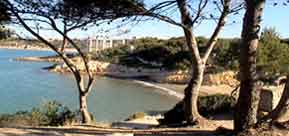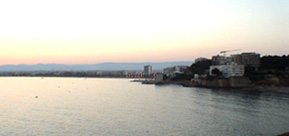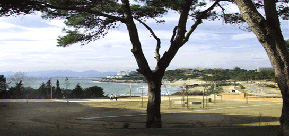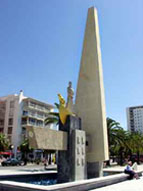 |
 |
 |
 |
 |
 |
 |
 |
| Home |
| History |
| General information |
| The coast of salou |
| Beaches Salou |
| Cultural Installations |
| Services |
| Links |

| ©Guinovart & Martí | You can optimily see this web through an 1024x768 screen resolution. | Contact |
| HISTORY |
.jpg)
The sea front that is occupied by Salou's territory, has been a human settlement since pre-history. But it was during the following centuries of the new era, with the iberian culture and roman civilization those that testify a well defined occupation of the territory. These were the times of the ancient city called Salauris, described by the poet Avi in his "Ora Maritima", and despite of no clear evidence, is commonly identified as Salou.
The end of the roman domination and the arrival of the muslims, origin a general decadency and an almost total unsettlement of these lands during centuries. The re-settlement of the territory did not begin until the mid Xth. Century with the handing out of letters, that gave the possesion of lands and rights to its beneficiaries. This is the case of the Salou's letters of land rights dated on 1194, given by king Alfons I to Ximeno d'Artusella. It was not an easy job, in fact it was a several centuries process. Non the less, since the restauration of the Tarragona's church, and to XVIIIth century, Salou has been part of its patrimony. The XIIIth. century was marked by the special protagonism of the catalan-aragonese alliance and the personality of king Jaume I, who knew of the excellent conditions of the natural port of Salou where he gathered a great armada that sailed to Mallorca on the 6th September of 1229.  During XVth. Century this part of the coast remained again almost inhabited due to war actions and piratry. The sacking, destruction and the risk of being captured by the muslim pirates, determined that the population searched for shelter in the inland villages. The construction of defensive towers such as Torre Vella, built in 1530, was not sufficient to stop these corsair attacks and to stop depopulation.
During XVth. Century this part of the coast remained again almost inhabited due to war actions and piratry. The sacking, destruction and the risk of being captured by the muslim pirates, determined that the population searched for shelter in the inland villages. The construction of defensive towers such as Torre Vella, built in 1530, was not sufficient to stop these corsair attacks and to stop depopulation.During the XVIIth and the XVIIIth centuries Salou's Port gained great importance due to its active commerce. Consequently several legal actions began between the different entities with interests in it (manufacturers and exporters of spirits, sailors union, Vila-seca village, Tarragona's archbishopric…). Meanwhile the city of Tarragona made hard efforts to gain the port primacy and to avoid Salou's port competivity, which was achieved on the XIXth. century. On the 31st. October of 1776 the Santa Maria del Mar Church was blessed, a humble chappel of a single nave and a bellfry, for the use of the sea's people. In the beginnings of the XIXth. century the dock was built as well as the port installations of customs, harbourmaster's office and the "llatzeret".. The lighthouse was opened in 1858, but at this time the decadence of Salou's port is an irreversible fact and only few ships harboured. In 1865 the railway station was opened and in 1887 the Carrilet was inaugurated. This was a local train between Salou and Reus that made the arrival to the beaches of Salou easier for the first holidaymakers. In the beginnings of the XXth. century the first attempts of organization, cleansing and urbanization of Salou began. In the twenties "xalet" (detached house) construction began of the present "passeig Jaume I" (Jaume I promenade), where the xalet Bonet. stands out from the others. .jpg) Since the sixties Salou experienced a spectacular urban growth based on tourism. The monument of Jaume I, built in 1965, is considered the symbol of the present Salou.
Since the sixties Salou experienced a spectacular urban growth based on tourism. The monument of Jaume I, built in 1965, is considered the symbol of the present Salou.At the end of the seventies the old aspiration of being an independent community took a new impulse. The formation of a wide and well organized popular segregationist movement was the motor of a long legal process that ended on the 30th October 1989 with the Spanish High Court sentence that gave Salou the segregation of the old municipality of Vila-seca i Salou. The first town council of Salou was set on 27th January 1990. An administrative commission undertook its functions until the municipal elections of 1991, the first for the new municipality of Salou. Since the birth of the municipality Esteve Ferran i Ribera has first been the chairman of the administrative commission and since 1991 the mayor. |